How To Install A Vapor Barrier Under A Mobile Home
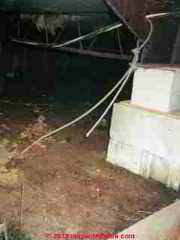 Mobile Domicile Belly Wrap & Insulation
Mobile Domicile Belly Wrap & Insulation
Manufactured home bottom board insulation & rodent bulwark
- Post a QUESTION or COMMENT about repairing or installing insulation under the flooring of manufactured or mobile homes or trailers: the belly insulation, belly board, or belly wrap.
InspectAPedia tolerates no conflicts of interest. We accept no relationship with advertisers, products, or services discussed at this website.
Manufactured abode, mobile abode & trailer abdomen or flooring insulation & rodent barrier or moisture bulwark/
How to inspect, repair, or replace the insulation under the floor of a manufactured habitation, mobile home, or trailer.
What is a mobile home belly wrap or bottom lath? Is it insulation or just a rodent bulwark or wet barrier? It depends.
This article series discusses how to inspect, diagnose and correct problems in mobile habitation, doublewide, or trailer & camper insulation or ventilation systems.
Nosotros likewise provide an Commodity Alphabetize for this topic, or you tin endeavour the page top or bottom SEARCH BOX every bit a quick mode to observe data y'all need.
Add together or Repair Manufactured Home or Mobile Home Abdomen Insulation
 Question: What kind of insulation practise I use for under the belly of my manufactured mobile habitation and where tin I purchase information technology ?
Question: What kind of insulation practise I use for under the belly of my manufactured mobile habitation and where tin I purchase information technology ?
2018/07/22 Tina Wilson said:
What kind of insulation do I apply for under the abdomen of my manufactured mobile home and where can I purchase it ?
[Click to enlarge any image]
This question and respond were posted originally at MOBILE Domicile INSULATION & VENTILATION.
The reader has not provided photos of the crawl space under her manufactured - mobile home, only we take adapted photographs from several sources to illustrate abdomen-wrap problems and solutions.
Photo higher up: adapted from MOBILE HOME Abdomen INSULATION RETROFIT [PDF] a U.S. Department of Energy power point presentation cited in detail below.
Our photo shows black plastic used to wrap or re-wrap the belly of a mobile home and boosted plastic that has been placed on the ground to act as a moisture barrier. The skirting on this dwelling house has been removed but must be replaced at the completion of the work.
Sentinel out: when working under a mobile habitation, manufactured home, or whatever tight crawl space in that location may be serious wellness and safe hazards.
More than one reader have reported getting an electrical daze while working under a mobile or manufactured domicile. Hazards in such tight spaces are outlined
at MOBILE HOME Crawl SPACES and also
at CRAWL Space Prophylactic Communication
Answer: Mobile home belly-board or lesser-board insulation suggestions & materials & sources:
Tina
When choosing an insulation to use nether the belly or bottom board of your manufactured domicile or mobile home you want to answer a few questions beginning:
- Is there already insulation under the abode?
If the home has no insulation or its insulation is extensively damaged or missing then you want to choose the right new insulation for the whole task.
If your present home has exposed fiberglass insulation over an un-protected clamber infinite, in my Opinion information technology would be an improvement to replace exposed fiberglass with a plastic enclosed insulation or a solid foam lath insulation.
That's considering I don't want to hazard the un-protected insulation becoming damp, mold infested, or rodent infested.
That'southward too why information technology'south important to put downwards a moisture/vapor barrier on the footing under the dwelling and to exist sure that surface runoff is directed away from the abode, not nether-it.
- Should the existing insulation be removed? Is an existing rodent barrier damaged? Is the insulation rodent-infested, wet, or moldy?
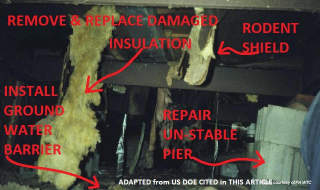
In this case the insulation should be removed and the exposed surfaces, if moldy, cleaned and sealed.
Scout out: With the one-time rodent barrier and damaged insulation removed it is also easier to check for damaged (or rodent-chewed) wiring, damaged, loose, leaky ductwork, and for signs of water leaks from to a higher place.
All of these demand to be repaired earlier proceeding. The mobile dwelling crawl infinite insulation damage, rodent barrier damage, and questionable concrete cake pier shown in the photo are labeled and adapted from MOBILE HOME BELLY INSULATION RETROFIT [PDF] a U.Due south. Department of Energy power betoken presentation cited in detail below.
In the photo,adapted from the US DOE who used a photo from the PA WTC (cited below), nosotros take pointed out damaged insulation that is likely also to exist wet, mayhap moldy and rodent-infested - that insulation should exist removed for wellness reasons and of grade considering falling into the crawl area beneath the mobile home it's too completely ineffective.
We also point out that the rodent shield has been torn and needs repair or replacement - since nosotros're removing the insulation the rodent shield will be removed as well.
We besides point out what looks like a dry-stacked tipped supporting pier of concrete blocks that, if it'south leaning or as well tall, is un-stable and thus unsafe.
- What is the climate where the abode is located? if your dwelling house is in a warm climate, a simple, thin "abdomen-board" or "bottom board} woven polyethylene textile may exist sufficient.
If you lot're in a colder climate and if the dwelling has little or no under-floor insulation, you probably want more insulation under the home using manufactured domicile belly insulation methods ii or 3 that I'll describe below.
Also come across MOBILE HOME ENERGY ZONES for aid deciding how much insulation you demand.
- Practice nosotros demand all new materials or volition some simple patching exist sufficient?
If most of the mobile or manufactured home abdomen wrap and insulation are intact and united nations-damaged, and if inspection from below does not show signs that in that location have been leaks into the flooring insulation and wrap from above, it may make sense to buy a patch kit or patching record to only repair the existing bottom board wrap.
You nonetheless want to assure that there is a skillful wet barrier on the ground below the domicile, intact skirting, and that there are no other structural, pier, tie-down, or other impairment or defects that would make the home un-stable or unsafe.
See MOBILE Dwelling CRAWL SPACES for more than inspection points.
See too MOBILE Dwelling SKIRTING
Mobile/Manufactured Home Lesser Board Insulation #one - replacing a rodent barrier
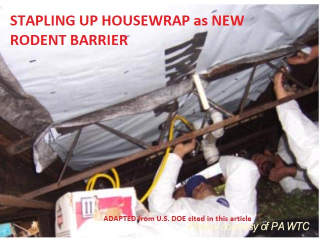
Photo: workers installing Typar, a constructed fabric housewrap that keeps h2o out but also does not trap moisture nether the mobile abode floor. Notice that the workers are wearing protective wearable and hats simply no gloves, no eye protection, no dust protection.
If the rodent bulwark was damaged and insulation wet, moldy, or rodent infested, for health and sanitation that insulation should be removed, bagged, and discarded as structure waste.
A substitute commonly used to replace the factory-installed rodent barrier, and an culling to polyethylene fabric bellyboard insulation is housewrap.
Housewrap is a h2o barrier that keeps water out only also won't trap h2o vapor or moisture inside the floor structure.
Details are at HOUSEWRAP AIR & VAPOR BARRIERS
Watch out: Before installing the housewrap or new belly wrap or bottom-board wrap, remember to bank check wiring, air ducts, plumbing, leaks, as I suggested to a higher place. Don't block a floor joist space that was used for HVAC duct purposes - install ductwork in that space beginning, connecting it to the HVAC air supply source and destination registers.
Watch out: if combustion air for a water heater or furnace is taken from underneath the home do non block that air inlet or your heating organization will be unsafe, maybe fatal.
With whatsoever necessary surface cleaning done, ductwork consummate and any needed repairs to wiring, plumbing, or damaged floor, you are ready to install the housewrap as a new rodent seal.
Housewrap is stapled to the under-side of floor joists, wrapping it around the heart I-axle and cutting and taping the wrap around whatsoever penetrations for plumbing, wiring, etc. To prevent the housewrap from sagging when insulation is added, you can apply woods lath tacked beyond joist bottoms on 24" centers or whatsoever similar back up.
With housewrap in place, if insulation is to be added continue with insulation choice #3 given below.
Mobile/Manufactured Home Bottom Board Insulation #two - bellyboard / bottomboard polyethylene
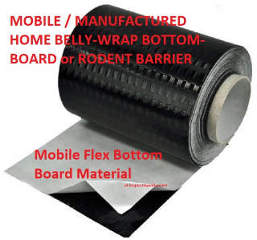 If you're doing just small repairs to the insulation nether your manufactured habitation, there are repair tapes or "Gorilla tape" that may stick well to the existing abdomen-insulation covering layer.
If you're doing just small repairs to the insulation nether your manufactured habitation, there are repair tapes or "Gorilla tape" that may stick well to the existing abdomen-insulation covering layer.
There are also small repair kits that include replacement sections of woven polyethylene bottom board or abdomen-board insulation.
Where to buy belly-board insulation
Manufactured home and mobile home builders and suppliers likewise equally Home Depot, Lowes edifice suppliers, Walmart, and even online vendors including Amazon all sell "bellyboard" or "bottom board" insulation equally well as repair kits and repair tape.
Typically the material is a made of several layers of polyethylene, including a woven polyethylene, sometimes with an insulating fiberglass or other textile sealed in the center ply - the belly-board insulation textile is completely enclosed in plastic to exist waterproof and is normally sold in rolls.
A typical example is Mobile Flex Bottom Board Material like that shown in our paradigm above is sold in a roll that's 4 ft x fourteen ft. This is a woven polyethylene fabric that is waterproof.
Here is how mobilehomepartsstore.com describes this cloth:
Repairs holes, cuts and tears resulting from plumbing repairs, weak seams and damage past animals. 30" Width 10 100' Length Non Agglutinative - A special lesser closure woven from black tapes of high density polyethylene and extrusion coated with a continuous layer of blackness low density polyethylene.
Mobile Flex is impervious to h2o, its strength can not be adversely affected by water. Because of its black polyethylene coating, Mobile Flex Qualifies as a vapor barrier. UL Classified every bit to flammability, tested at zero flame spread and zero smoke developed. Radco approval #1028. - 2022/07/22 https://mobilehomepartsstore.com
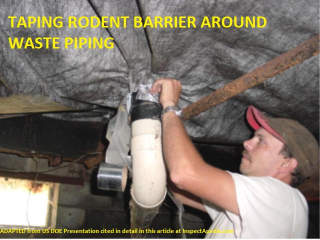
The U.S. DOE photo shown hither illustrates a worker taping the waste piping penetration of the rodent barrier in a basement nether a manufactured abode.
The grayness fabric overhead is a synthetic housewrap textile. The manufacturers of MobileFlex and like abdomen-wrap materials argue that using that special material works better around penetrations.
The [Mobile Flex belly wrap] material is uniform in quality with no weak spots. Penetrations or cuts will non spread and can be easily patched. - 2022/07/22 https://mobilehomepartsstore.com
Costs of Bellywrap vs. Housewrap for Manufactured & Mobile Home Floors
Rolls of bottom board insulation are sold in 4ft ten 14ft rolls every bit well as other dimensions.
- Costs range from under $20. U.S. for a repair kit to about $120. U.S. for woven tape high-density polyethylene bottomboard that's fourteen'4" wide x 70' long, to about $340. for a four' x 600' roll of Mobile Flex fabric. (4' ten 600' / 340 = $vii.06 /sq.ft.)
- A iii' x 100' gyre of DuPont Tyvek HomeWrap™ sells for much less: almost $60. U.S. at a typical DIY abode eye. (3' 10 100' / $threescore = $5 ./sq.ft.)
- A nine' x 150' roll of Typar™ housewrap lists for about $325. U.S. at Dwelling Depot (2018 prices). (9' x 150' / $325 = $4.fifteen / sq.ft.)
Mobile/Manufactured Abode Bottom Board Insulation #3 - add solid foam board insulation nether the abode
In cold climates an approach to energy retrofit for manufactured or mobile homes bottom insulation is to cover the under-side of the floor frame (if information technology's non already covered) solid foam and and then blow-in insulation (approach #3 below) or to cut and fill the flooring joist space with solid foam before covering the bottom with a continuous foam layer.
Really? I'grand non a fan of trying to fill the space between floor joists with custom-cut solid foam insulation for a couple of reasons.
If the cream is not cut precisely and gaps are left at the sides or ends those form heat loss points that can lose a pregnant percentage of the do good of insulating in the first place. If the floor joists are not very evenly spaced every joist bay insulation has to be custom-cut accurately
There may exist besides a bit of wastage: if you purchase 48" wide insulating board and the flooring joists are xvi" on center you'll discover you are cutting fourteen 1/2" wide insulating board sections. Yous can get three pieces out of a 48" broad board, wasting 4.five" of every insulating board section. Owens Corning Formular 250 sold in 2" x 24" x 96" (8 ft.) sizes will exist even more wasteful, wasting 9.5" of width of every piece of fabric.
And so loose make full insulation is blown-in to the floor space from the home floor edges, from outside or from under the home through slits in an existing belly-lath covering.
With very little waste, however, following manufactured/mobile home floor insulation pick #iii given below, you lot could encompass the bottom of the joists with 1" thick Loftier-R foil faced foam insulation. Use foil tape to seal all joints later installation of the foam board.
Watch out: See the practical and safety warnings almost installing under-floor insulation of manufactured or mobile homes that we requite in the next section below.
Mobile/Manufactured Home Bottom Lath Insulation #4 - Blown-in loose-fill up fiberglass or mineral wool
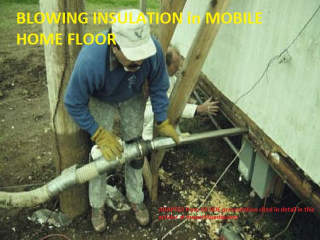 In cold climates an approach to energy retrofit for manufactured or mobile homes bottom insulation is to cover the nether-side of the floor frame (if it's not already covered) with belly-board or plastic sheeting or even solid foam.
In cold climates an approach to energy retrofit for manufactured or mobile homes bottom insulation is to cover the nether-side of the floor frame (if it's not already covered) with belly-board or plastic sheeting or even solid foam.
Then loose fill insulation is blown-in to the floor space from the habitation floor edges, from outside or from under the home through slits in an existing belly-board roofing.
Watch out: practise not blow insulation under the floor of a home without first checking the location and condition of heating supply and return air ducts. You lot also must map the location of any electrical boxes or plumbing traps that might demand future access, and for electrical boxes, maintain a point of access.
You'll also demand to seal whatever holes through which insulation might be lost, and where any between-floor-joist spaces were used for HVAC air returns, those volition need to be converted to actual ductwork before insulating. - Midwest Weatherization Best Practices Field Guide Section 3201 Floor Insulation (2007) - cited below.
Lookout out: inspect and secure any loose electrical wiring, plumbing, or other mechanicals before blowing-in insulation.
Watch out: likewise if blowing in insulation over bellyboard fabric that'due south loose or sagging: secure whatever loose belly-board or bottom-board membranes and add together support where sagging.
Sentinel out: putting any not-permeable insulation under the floor framing of a manufactured home, mobile domicile, or any construction tin can pb to problem IF water leaks from above or wet from below laissez passer through openings, tears, or omitted spaces where it can then become trapped in the floor structure - inviting insect attack, mold, and rot.
Then if there'southward not already a good wet barrier on the footing, add one get-go - it'll make working under the habitation easier and cleaner. Use a 6-mil or thicker polyethylene sheeting sold for that purpose.
Using solid foam board can give college insulation or R-value (useful if your habitation is in a cold climate), just I would consider either taping the joints with foil or polyurethane tape or adding a half dozen-mil plastic barrier on the "down" side of the floor since getting a barrier on the warm or upper side when working from below is an excruciating corporeality of trouble once a domicile has already been constructed.
Spotter out: foam insulation (except for fire-rated foam) cannot be left exposed in the living area of homes - that'south a burn chance and code violation.
Check with your local building department as well as your dwelling's manufacturer before choosing any insulation that'southward unlike in properties from what was used by the original manufacturer.
Sources & Codes for Insulating & Weatherizing Mobile Homes & Manufactured Homes
Where to buy mobile home or manufactured dwelling insulation & belly board or belly-wrap products. These products are sold by local building supplies such every bit Habitation Depot, Lowes, Menards, and as well by online vendors of whom nosotros include examples beneath.
- HSMHS Bottom Lath Fabric, 28' x 100' (not self-adhesive) ($20 TO $200 depending on size) at HS MHS, 15445 Lee Hwy Bristol VA, 24201 USA, Tel: 276.669.9133 Website: https://hsmhs.com/ besides sold (at a higher price) on Amazon
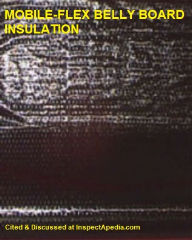
- Mobile Flex Black Bottom Board, sixteen' x eighty' (shown above) at about $150. USD, is sold past various online and local vendors such as Mobile Home Parts Store, website: mobilehoepartsstore.com Tel: 888-277-7720
Website extract: Repairs holes, cuts and tears resulting from plumbing repairs, weak seams and damage by animals. sixteen' Width 10 80' Length - A special bottom closure woven from blackness tapes of loftier density polyethylene and extrusion coated with a continuous layer of black low density polyethylene. The cloth is uniform in quality with no weak spots.
Penetrations or cuts will not spread and can be hands patched. Mobile Flex is impervious to h2o, its strength can not exist adversely afflicted by water. Because of its black polyethylene coating, Mobile Flex Qualifies as a vapor bulwark. UL Classified as to flammability, tested at zero flame spread and nil smoke adult. Radco approval #1028.
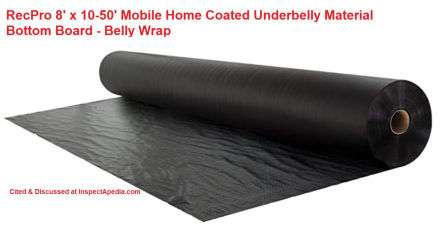
- RecPro 8' x 10' (shown to a higher place) Mobile Home Coated Undebelly Cloth - Bottom Lath Material, also avaiable in lengths to fifty', from online vendors (including Amazon) and from mobile and manufactured home suppliers.
- CRAWL SPACE Moisture CONTROL, [PDF] U.S. Department of Energy
- MOBILE Home SKIRTING - including insulated mobile dwelling house skirting panels
- Scott, Bob & Lyn M. Bartges, WEATHERIZING MOBILE HOMES" [PDF] Home Energy, July/Baronial 2004, Website: www.homeenergy.org, copy provided past the U.S. DOE at the link cited below
- U.S. DOE, MOBILE HOME Belly RETROFIT [PDF] Midwest Weatherization All-time PRACTICES , WEATHERIZATION INSTALLER/TECHNICIAN MOBILE HOMES - CHAPTER 3: [PDF] U.S. Section of Energy, Role of Energy Efficiency & Renewable Energy, Retrieved 2022/07/22, original source: https://world wide web.energy.gov/eere/wipo/downloads/weatherization-installertechnician-mobile-homes-chapter-3-mobile-home-belly
- United states DOE MOBILE HOME Abdomen INSULATION RETROFIT [POWER POINT PRESENTATION], U.S. DOE, Website: eere.free energy.gov, retrieved 2022/07/22, original source op. cit. file: PPT-3-mobile-home-abdomen-retrofit.ppt
- Us DOE WAP, Midwest Regional Field Office. Midwest Weatherization All-time Practices Field Guide May 2007: 191-194.
- [1] "Energy Efficient Mobile Homes", retrieved 5/15/xiv, original source http://free energy.gov/energysaver/articles/free energy-efficient-manufactured-homes
Excerpts:
Like site-built homes, new manufactured homes (formerly known as mobile homes) can exist designed for energy efficiency and renewable energy. You can also remodel or retrofit older manufactured homes to improve energy efficiency and/or add renewable energy equipment. Manufactured homes are built in a factory on a permanent chassis, and so transported to a building site and installed.Manufactured Abode Energy-Efficient Retrofit Measures There are many differences between manufactured (mobile) homes congenital before the U.S. Department of Housing and Urban Evolution (HUD) Code took effect in 1976 and those congenital after. If you have a pre-1976 manufactured (mobile) home, you lot can make the following energy efficiency improvements to reduce heat loss:
Install energy-efficient windows and doors
Add insulation to the belly Make full general repairs (caulking, ducts, etc.)
Add together insulation to your walls Install insulated skirting Install a belly wrap Add insulation to your roof or install a roof cap.
Experiments conducted on pre-1976 manufactured homes by the National Renewable Free energy Laboratory (NREL) from 1988 to 1991 institute that these retrofit measures resulted in a 31% reduction in heating fuel usage.
There are three mutual methods used to add roof insulation to the existing crenel: drilling and tube blowing from the within, drilling and tube blowing from the top, and rolling back the roof and blowing into the now open crenel. Instead of filling the existing cavity, some installers prefer to utilise roof caps for insulating.
Although the insulating performance of roof caps is inferior to blown-in insulation, they come in kits that include insulation boards (usually of dense fiberglass) with a synthetic prophylactic or metal covering. Roof caps can insulate the roof to R-19 without disturbing the existing roof, and if all leaks in the old roof covering are sealed, the old roof acts as a vapor retarder, eliminating moisture problems and the demand for ventilation.
Be aware that rolling back the roof to add together insulation tin can lead to realignment bug and leaks, necessitating mechanical ventilation to alleviate moisture condensation problems in the roof cavity.
Blowing loose-fill insulation into an existing manufactured domicile is difficult because of the narrowness of the wall and roof cavities. Pre-1976 dwelling walls often take only 2-inch by 2-inch studs (v.08 cm × 5.08 cm) (new manufactured houses are required to have at least 2-inch past 4-inch [5.08 cm × 10.xvi cm] studs), and roof trusses complicate the process of calculation more than roof insulation.
Blowing insulation into wall or ceiling cavities and/or installing roof caps is a job for a trained professional with proper equipment. Neither action should be attempted by even the most capable do-it-yourselfer, as permanent structural damage and/or personal injury could easily result. A proficient source for a recommendation of a capable contractor-installer would probably exist the Weatherization Section of your local Community Action Agency.
To further improve your manufactured home'southward energy efficiency, consider:
Caulking and weatherstripping windows and doors, especially if you can't replace them with more free energy-efficient ones Air sealing whatever openings around plumbing fixtures and ducts Using energy-efficient lighting and appliances. Manufactured Habitation Renewable Energy Applications You can use renewable energy to provide electricity, heating, and cooling for your manufactured home. Renewable energy systems non only lower free energy costs, but also reduce pollution from fossil fuels.
You might consider:
Installing a geothermal oestrus pump (GHP), which can provide space heating and cooling. GHPs are most toll-effective to install at the same time as the manufactured home. The systems can't be moved, and then GHPs only work for permanently sited manufactured homes. Using passive solar blueprint by adding a sunspace, orienting the dwelling house to maximize solar exposure, landscaping for energy efficiency, and using shading devices. Investigating solar water heating. Although the lightweight construction of some manufactured homes limits roof support for heavy solar collectors, you can use lightweight roof-mounted air collectors for h2o heating or install the heavier liquid-type solar collectors on the ground. These systems are all-time suited for manufactured homes that are seldom moved.
Installing solar electric or photovoltaic (PV) systems, which are low-cal enough to install on the roof of a manufactured home. Installing a small current of air electrical system to generate electricity if your manufactured dwelling is or volition be located in a rural area on at least 1 acre of land. Installing a microhydropower organisation to generate electricity if your manufactured home is or will be located where you have access to flowing water. Although you can move a microhydropower system, yous tin't take the hydropower resource with you, which makes these systems best suited for permanently sited manufactured homes.
Manufactured Dwelling HUD Code Requirements
Manufactured homes are subject to the Manufactured Domicile Structure and Condom Standards or "HUD Lawmaking" rather so local building codes, and display a red certification label on the exterior of each transportable section. The HUD lawmaking is a fix of manufactured home manufacture standards published and maintained past HUD that establishes standards for pattern and structure, strength and immovability, fire resistance, energy efficiency, transportability, and quality command. It likewise sets performance standards for the heating and ac, plumbing, thermal, and electrical systems.
- HUD Manufactured Housing Construction and Safety Standards, The Hud Lawmaking 24CFR 3280, available from the U.Due south. Government Press Function, online at http://www.gpo.gov/fdsys/pkg/CFR-2001-title24-vol1/content-detail.html
- HUD Code: 42 U.s.C. 17071 - Free energy Code improvements applicative to manufactured housing [PDF], retrieved 5/15/14, original source: http://world wide web.gpo.gov/fdsys/pkg/USCODE-2010-title42/pdf/USCODE-2010-title42-chap152-subchapIII-partA-sec17071.pdf
- HUD Lawmaking: 62 FR 24337 - Manufactured Housing: Statement of Policy 1997-1, State and Local Zoning Determinations Involving... [PDF], retrieved four/fifteen/14, original source: http://www.gpo.gov/fdsys/pkg/FR-1997-05-05/pdf/97-11535.pdf
- HUD Code: lxx FR 61178 - Manufactured Housing Dispute Resolution Plan [PDF] , http://world wide web.gpo.gov/fdsys/pkg/FR-2005-10-20/pdf/05-20953.pdf
- *HUD Code: 78 FR 73965 - Manufactured Home Construction and Safety Standards [PDF] , "24 CFR Part 3280, Manufactured Home Construction and Prophylactic Standards, Terminal Dominion, (2013), * this is the key legislative rule from the U.S. Department of Housing and Urban Development, 24 CFR Function 3280, Docket No. FR-5221-F-)2, RIN 2502-!717, "Manufactured Dwelling Construction and Safety Standards", 9 Dec 2022.
http://www.gpo.gov/fdsys/pkg/FR-2013-12-09/pdf/2013-28775.pdf - HUD Code: 3. Serial No. 112-96 (HOUSE Hearing) - IMPLEMENTATION OF THE MANUFACTURED HOUSING IMPROVEMENT Deed OF 2000 [PDF] , http://www.gpo.gov/fdsys/pkg/CHRG-112hhrg75068/pdf/CHRG-112hhrg75068.pdf
Reader Q&A - also run into the FAQs series linked-to below
Richard
Cheers for asking nigh mobile habitation crawl space belly wrap alternatives.
I'1000 not sure about "legally" since that's the decision of your local building code official.
Practically you can do what you want but you lot should effigy there'south a reason for that belly wrap: mostly to continue out critters and moisture who, if either invades the insulation, volition make the dwelling occupants sorry.
Y'all could attempt to build a conventional clamber space effectually the dwelling house and likewise put down a sufficient poly vapor barrier to continue the infinite dry out, provided you also keep water from entering from roof or surface runoff;
But I think that the total cost will be quite a bit more than using abdomen wrap and conventional skirting.
Anybody that I have read, addresses repairing and replacing the abdomen wrap under a mobile home.
My question is simple, can you lot legally remove the abdomen wrap and diddled in insulation and merely seal/insulate the crawlspace like on a site built home?
(Encapsulation) I have a brick and mortar skirt/foundation, so I don't encounter why you couldn't.. Please give communication pertinent to N Carolina.. Thank y'all
Jared
If y'all can remove the belly wrap carefully and without tearing information technology up - to give access to the insulation - then yous should certainly be able to reuse it.
Just make your cuts at a place where you tin staple the belly wrap dorsum up. Don't make a cutting in between floor joists.
Question I have squirrels that got in my under belly and are now in my insulation there are a few holes from where they entered but other and then that the abdomen wrap is skillful . ,I live in the yukon so I what I need to do is supersede the insulation I'm merely wondering if I would have to replace the under wrap or could I cut holes in replace the insulation and then repair
Fair question, Ken
Reducing the moisture manual under any home reduces the run a risk of a mold or rot or insect attack problem. Building and weather conditions and home conditions alter over the homes life and then I don't assume that because home hasn't had a problem yet that it can't have one.
That said if you want to hear an argument of the contrary view we could say that edifice scientists requite advice that's generally correct. If every problem that we worried nigh it happens all the time and every instance no one would enhance these questions. Problem is we don't know which instance will turn into a problem in which volition non
only in the process of purchasing a trailer and a recommendation to vapor seal the crawl space ? It is 40 years quondam why now
Georgia
Earlier we tin suggest whatsoever repair methods or materials nosotros demand to know what we're repairing: are y'all replacing moisture insulation, torn underbelly wrap, or something else?
Had a water leak nigh the fresh h2o plough off. Big 1...emergency repair simply need Info on the repair of the underbelly .....its not a huge space. Nether dorsum bathroom vanity and camode. 1975 double wide . And then what exercise I need to do. Prices here are just robbery.
Greg
Cheers so much for taking time to read with care and to write about an mistake in our text; I reviewed and edit the article to right a couple of adding errors that were off just a few cents.
The basic formula nosotros used is
(Square anxiety of insulation) / Cost for that unit of measurement or packet
Example:
A 3' x 100' roll of DuPont Tyvek HomeWrap™ sells for much less: almost $threescore. U.S. at a typical DIY home middle.
(3' x 100' / $60 = $v ./sq.ft.)
or
300 sq.ft. / $60. per curl giving that many sqft. = $five. The states
Greg
Thank you so much for taking fourth dimension to read with intendance and to write most an mistake in our text; I volition review and edit the article accordingly.
Daniel
Check your math in section on cost of abdomen wrap.
You lot have the divisor and dividend reversed. It is much less per square pes than your figures.
I'one thousand selling my mobile home in Prescott, and need underbelly insulation to nearly half of the home. Practise you know of any contractors that does this sort of projection? Need the piece of work washed asap. Please telephone call me at 352-428-2887. Thank you. I also need the water heater replaced. HELP!
Cory
To insulate and install belly wrap under a typical mobile home has these costs for which we provide a VERY rough estimate in U.Southward. Dollars, as I'll explain in a moment.
- Insulation: assuming a fiberglass insulation blanket, batts, or rolls, $l. to $300. varying by material and thickness
- Belly wrap material: $150. to $400. depending on expanse or size needed, may be combined with the insulation in a single product, making installation easier;
- Labor: $250. - $500. / day of labor; readily-accessible crawl space jobs can be completed in a day if at that place are no other repairs to be made;
There are some variables that volition change the installation price of mobile home belly-insulation and belly wrap: such as
- size of the home: singlewide (14-18' wide x 60-90' long), doublewide 28'-36' wide x 60'-90' long): length, width.
- labor costs for the country and metropolis where the domicile is located
- ease of access below the mobile habitation
- whether or non there are repairs that must be made before installing the insulation and belly wrap, such equally plumbing leaks or damaged electrical wiring
- choice of insulating material (e.grand. foam spray may be more constructive simply also more costly, blown-in requires that a rigid board insulation be already in place under the dwelling's
floor frame).
How much does a contractor accuse to replace Insulation and nether belly on mobile home
Ken
Delight take a look through the article above on this page where I describe the different types of mobile habitation belly insulation and in the commodity also requite some examples of types, Brands, and places to buy starting at the commodity department titled
Where to buy belly-board insulation
later you've read that if you lot have any question whatever please don't hesitate to enquire and nosotros'll exist glad to inquiry or get into further detail
For mobile home underbelly what kind of insulaton should I utilise
...
Continue reading at MOBILE HOME INSULATION & VENTILATION or select a topic from the closely-related articles below, or see the complete ARTICLE INDEX.
Or run into these
Recommended Manufactures
- Crawl SPACE VENTILATION CODES
- Estrus LOSS R U & One thousand VALUE CALCULATION
- HOUSEWRAP AIR & VAPOR BARRIERS
- INSULATION AIR & Rut LEAKS
- INSULATION LOCATION - WHERE TO PUT IT
- MOBILE HOME Crawl SPACES - how to audit the mobile home crawl infinite
- MOBILE HOME Energy ZONES
- MOBILE Abode HEATING SYSTEMS
- MOBILE HOME INSULATION Abdomen WRAP
- MOBILE HOME INSULATION & VENTILATION
- MOBILE Home SKIRTING
- WINTERIZE A BUILDING
Suggested citation for this web page
MOBILE Dwelling house INSULATION BELLY WRAP at InspectApedia.com - online encyclopedia of edifice & environmental inspection, testing, diagnosis, repair, & problem prevention communication.
Or run into this
Index to RELATED ARTICLES: Article INDEX to MANUFACTURED & MOBILE HOMES
Or use the SEARCH BOX found below to Ask a Question or Search InspectApedia
...
Enquire a Question or Search InspectApedia
Try the search box simply below, or if you lot adopt, post a question or annotate in the Comments box below and we volition answer promptly.
Search the InspectApedia website
Note: appearance of your Comment below may be delayed: if your comment contains an image, web link, or text that looks to the software as if information technology might be a web link, your posting will appear afterwards it has been approved by a moderator. Apologies for the delay.
Technical Reviewers & References
Click to Evidence or Hide Citations & References
Publisher InspectApedia.com - Daniel Friedman
Source: https://inspectapedia.com/Manufactured_Homes/Mobile-Home-Belly-Wrap-Repair.php
Posted by: beamonsomint.blogspot.com


0 Response to "How To Install A Vapor Barrier Under A Mobile Home"
Post a Comment